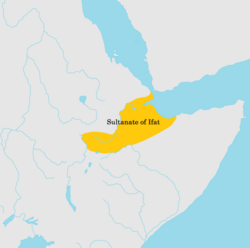
Back سلطنة عفت Arabic Ifat AST ایفات سولطانلیغی AZB Ifatski sultanat BS Ifat Catalan Sultanat Ifat German Ifat Spanish سلطنت ایفات Persian Ifat Finnish Sultanat d'Ifat French
Sultanate of Ifat سلطنة أوفات (Arabic) | |||||||||
|---|---|---|---|---|---|---|---|---|---|
| 1275–1403 | |||||||||
 The Ifat Sultanate in the 14th century. | |||||||||
| Capital | |||||||||
| Official languages | Arabic | ||||||||
| Common languages | |||||||||
| Religion | |||||||||
| Government | Monarchy | ||||||||
| Sultan | |||||||||
• 1185–1228 (first) | Umar Walasma | ||||||||
• 1376–1403 (last) | Sa'ad ad-Din II | ||||||||
| History | |||||||||
• Established | 1275 | ||||||||
• Disestablished | 1403 | ||||||||
| Area | |||||||||
• Total | 120,000 km2 (46,000 sq mi) | ||||||||
| Currency | Dinar and Dirham[2] | ||||||||
| |||||||||
| Today part of | |||||||||
The Sultanate of Ifat, known as Wafāt or Awfāt in Arabic texts,[3] or the Kingdom of Zeila[4] was a medieval Sunni Muslim state in the eastern regions of the Horn of Africa between the late 13th century and early 15th century.[5][6][7] It was formed in present-day Ethiopia around eastern Shewa in Ifat.[8][9][10] Led by the Walashma dynasty, the polity stretched from Zequalla to the port city of Zeila.[11] The kingdom ruled over parts of what are now Ethiopia, Djibouti, Somaliland, Somalia.
- ^ Endris, Mohammed. Self-Rule And Representation In Amhara National Regional State: A Case Study On Argoba Nationality (PDF). Addis Ababa University. p. 48.
- ^ Zakeria, Ahmed (1991). "Harari Coins: A Preliminary Survey". Journal of Ethiopian Studies. 24. Institute of Ethiopian Studies: 23–46. JSTOR 41965992.
- ^ Trimingham, J. Spencer (2013) [1952]. Islam in Ethiopia. London: Routledge. p. 58. ISBN 9781136970221.
- ^ E. Cerulli. Islam Yesterday and Today. p. 344.
- ^ The Editors of Encyclopædia Britannica (1998). Ifat: historical state. Encyclopedia Britannica. Retrieved 2017-01-16.
- ^ J. Gordon Melton and Martin Baumann, Religions of the World, Second Edition: A Comprehensive Encyclopedia of Beliefs and Practices, page 2663
- ^ Asafa Jalata, State Crises, Globalisation, And National Movements In North-east Africa page 3-4
- ^ Ullendorff, Edward (1966). "The Glorious Victories of 'Amda Ṣeyon, King of Ethiopia". Bulletin of the School of Oriental and African Studies, University of London. 29 (3). Cambridge University Press: 601. doi:10.1017/S0041977X00073432. JSTOR 611476. S2CID 162414707.
- ^ Østebø, Terje (30 September 2011). Localising Salafism Religious Change Among Oromo Muslims in Bale, Ethiopia. BRILL. pp. 56–57. ISBN 978-9004184787.
- ^ Pankhurst, Richard (1997). The Ethiopian Borderlands: Essays in Regional History from Ancient Times to the End of the 18th Century. The Red Sea Press. p. 39. ISBN 9780932415196.
- ^ Huntingford, G.W.B (1955). "Arabic Inscriptions in Southern Ethiopia". Antiquity. 29 (116). Cambridge University Press: 230–233. doi:10.1017/S0003598X00021955.